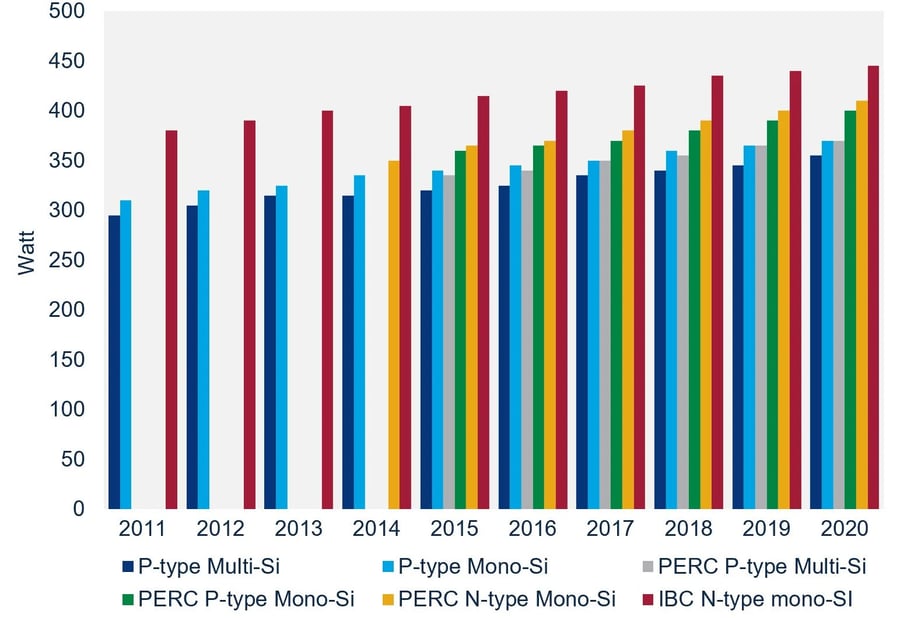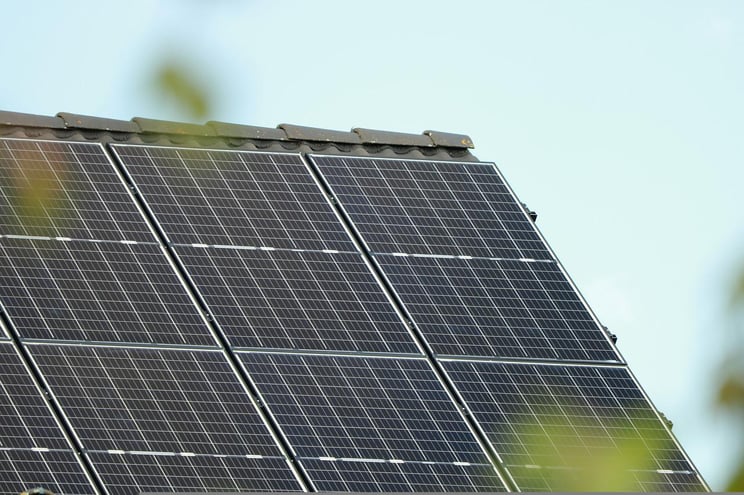In the space of just a few years, the average panel we install on domestic projects has shot up from around 315W to at least 375W, with more and more residential modules breaking the 400W barrier.
This is down to a few factors, such as the widespread adoption of new, more efficient technologies, bigger cells and bigger modules:

Source: Greentech Media.
Indeed, some manufacturers are pushing power output to the extreme – last year Risen Energy presented its 700W commercial panel.
Let’s take a look behind the rise of high power solar panels and ask if it’s really all good news...
New technologies
The solar market moves fast and you can see from the graph above the proliferation of new technologies that have emerged over the last decade:
- Monocrystalline modules have come to dominate the market, offering significantly higher efficiencies than polycrystalline due to their high purity silicon.
- N-type cells suffer less from light induced degradation than regular p-type cells, which can result in higher output over time. Some of the most efficient solar panels from manufacturers like Maxeon and REC use n-type cells, and the n-type market share is expected to grow to 50% by 2030.
- Interdigitated back contact (IBC) panels have no busbars on the front of the cells, maximising the surface area for capturing sunlight. This technology is a core part of the high performance SunPower panels.
- Passivated emitter and rear contact (PERC) cells offer enhanced efficiency and are now used in about 85% of modules, according to the ITRPV.
Solar cell size trends
Traditional solar cells were 156x156mm for many years, but recently manufacturers have been experimenting with larger sizes. These include 166mm, 182mm and 210mm squares. With sizes up to 80% bigger, the output per cell can be significantly greater.
Solar panel size trends
Not only are cells getting bigger, but manufacturers are putting more cells in each module. Obviously, this means panels are getting bigger.
Traditional sized panels are 60 (or 120 half-cut) cells for residential and 72 (or 144 half-cut) cells for commercial. This is about 1m wide by 1.5-1.9m high. Commercial modules have always been bigger because they don’t need to be packed into restricted roof spaces and can make more economical use of cabling.
Newer sized modules include those with 66 (132 half-cut), 78 (156 half-cut), or 84 (168 half-cut) cells. On the cutting edge are third cell panels, which are more viable with the largest 210mm square cells. This means modules could be anywhere from around 1x1.7m to 1.2x2.9m.
You can see how the trend for larger modules is expected to continue over the coming decade in the latest ITRPV report, especially for commercial scale:


Source: ITRPV 2022.
Pros and cons of high output solar panels
Pros:
- Higher efficiencies and W/m2 means you can generate more power from the same space, which is a clear improvement, especially as mass adoption brings the price down.
- Larger, higher output modules reduce the need for ancillary components like cabling to reach the desired output. At the utility scale, this can significantly lower the installation cost and therefore the levelised cost of energy.
Cons:
- Larger panels can be more difficult for installers to handle, especially if they catch the wind at the rooftop level. This is less of an issue for commercial installs on flat roofs or utility scale ground mounts, but can make residential installs more laborious.
- On smaller or more restricted rooftops, you may not be able to fit in as many panels if each module is larger. Depending on the proportions and layout, this could result in a lower overall output for the roof.
Are high power solar panels better?
The market is moving towards higher power solar panels. This is great for large scale solar, as it brings costs down and results in cheaper energy and better returns. On the residential side, high efficiency solar panels, which result in higher output, can maximise the generation possible from a tight space. But physically larger panels risk making designing and installing PV systems on domestic properties more tricky, if these are the only modules available.
Of course, the key question is do the most powerful solar panels offer value for money? If the uplift in output is greater than the cost increase then it’s certainly worth considering opting for high power PV. Though with supply levels and module prices fluctuating so much at the present time, it can be difficult to secure exactly the panels you’d prefer for each project. But the good news is that in the longer term, panel prices have tumbled such that you can now get a 345W panel for the one tenth of the cost of a 290W panel in 2010.
To make sure you always know ‘Watts up’ with modern solar panels, subscribe to our blog newsletter:










